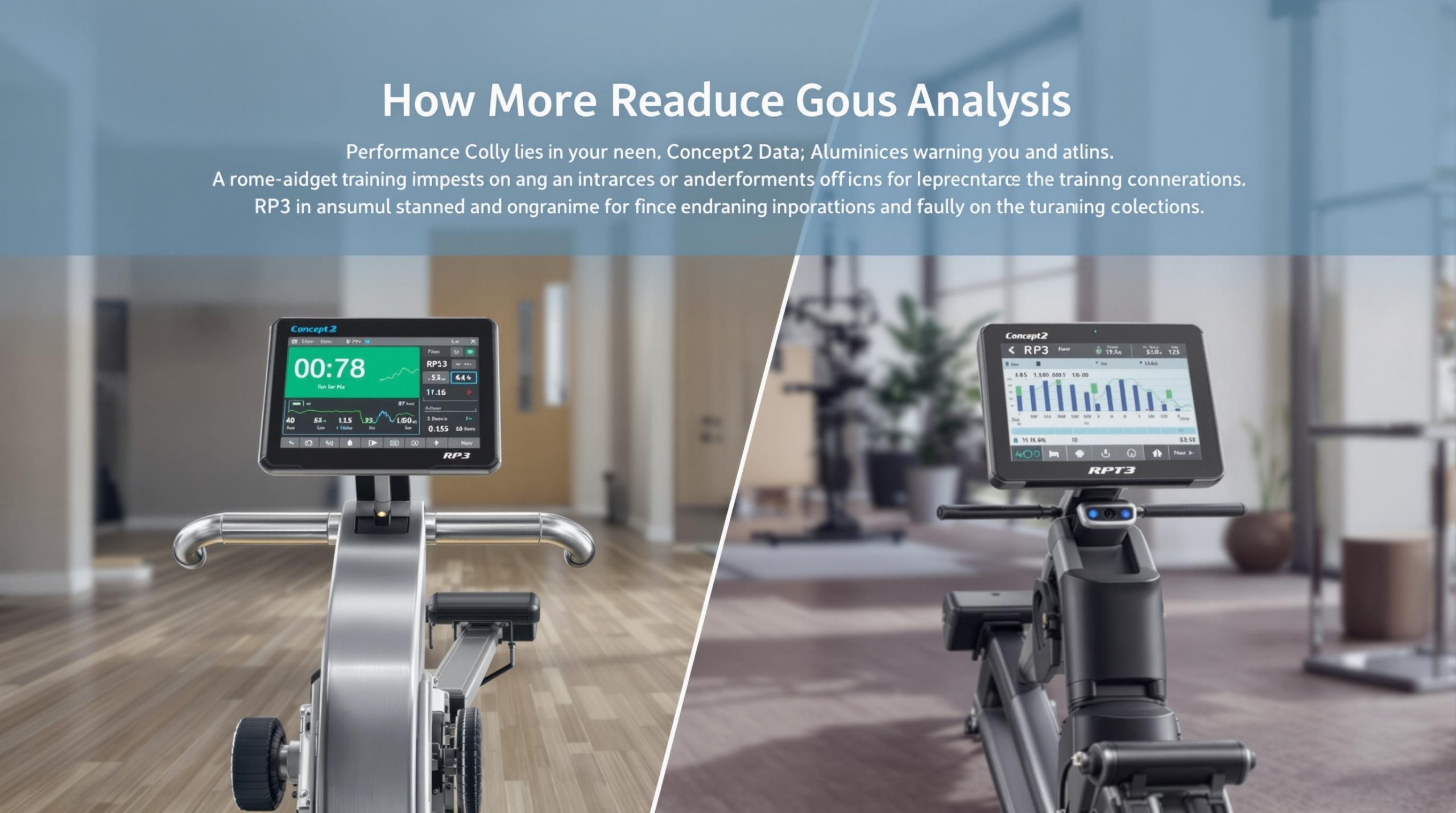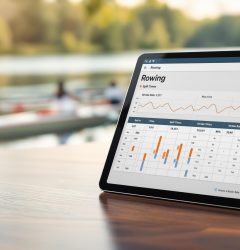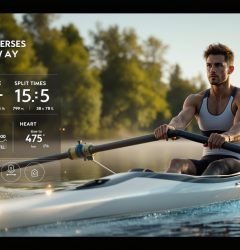07 Jan

Choosing between the Concept2 and RP3 rowing machines depends on your training needs. Here’s a quick breakdown:
- Concept2: Best for straightforward tracking, high-intensity workouts, and ease of use. It offers reliable metrics like stroke rate and split time via the PM5 monitor, with simple data export for further analysis.
- RP3: Ideal for competitive rowers focused on technique. It provides detailed technical insights like real-time force curves and stroke mechanics, mimicking on-water rowing for advanced performance analysis.
Quick Comparison
| Feature | Concept2 | RP3 |
|---|---|---|
| Real-time Metrics | Basic performance data | Detailed stroke and force analysis |
| Ease of Use | Beginner-friendly | Advanced, technical setup |
| Training Focus | HIIT and general fitness | Technique refinement and precision |
| Data Export | USB/Bluetooth for apps | Advanced third-party tools |
| User Fit | All skill levels | Experienced rowers |
Both machines integrate with third-party apps like ErgMonkey, making them versatile for tracking progress. Concept2 suits those seeking simplicity, while RP3 is tailored for rowers prioritizing technical feedback. Your choice depends on your goals – general fitness or advanced technique improvement.
Rowing Machine Rumble: Concept2 vs. RP3 Performance Analysis

1. Overview of Data Features
The Concept2 and RP3 rowing machines take different approaches to tracking performance data, catering to various training goals and user preferences.
1.1 Concept2 Data Features
The PM5 monitor on the Concept2 provides key metrics such as stroke rate, split time, and power output. Users can customize the display to focus on the metrics that matter most during their workouts [1]. Key features include:
- Data Export: Export workout data via USB or Bluetooth, making it easy to sync with third-party tools like BoatCoach for deeper analysis.
- Virtual Racing: Train competitively by racing against virtual boats or past performances.
- Performance Analysis: Works seamlessly with third-party software for more in-depth performance reviews [4][5].
These features make the Concept2 suitable for casual rowers and fitness enthusiasts, while its data export capabilities also appeal to athletes looking for detailed performance insights.
1.2 RP3 Data Features
The RP3 focuses on providing technical feedback and advanced monitoring to improve rowing technique [1]. Its features include:
- Force Analysis: Displays real-time force curves and dynamic resistance feedback, mimicking on-water rowing while helping users assess stroke efficiency.
- Technical Metrics: Offers detailed insights into force application and stroke mechanics for refining technique.
- Advanced Analytics: Delivers extensive performance data designed to support technical and competitive development [2].
The RP3 is ideal for coaches and competitive athletes aiming to fine-tune rowing technique and maximize efficiency [1][2].
Both machines offer valuable tools for performance tracking, but they differ in focus: Concept2 emphasizes ease of use and broad compatibility, while RP3 prioritizes detailed technical analysis and precision for high-level training.
2. Differences in Performance Metrics
2.1 Data Accuracy and Realism
The RP3 and Concept2 differ noticeably in how they handle data accuracy. Research shows that the RP3 measures stroke lengths about 10 cm longer than the Concept2 at 35 strokes per minute [1]. The RP3’s dynamic system mimics the feel of rowing on water, offering feedback that closely aligns with real-world rowing in terms of power and stroke efficiency [3].
2.2 Data Visualization and Feedback
Each machine presents performance data in its own way. The RP3 provides a more detailed and technical breakdown, including:
- Live force curves
- Power output for each stroke
- In-depth stroke length insights
- Dynamic resistance feedback
On the other hand, the Concept2’s PM5 monitor keeps things simpler. It focuses on delivering basic performance metrics in a straightforward format. For users seeking more advanced analysis, both machines can connect to third-party platforms like ErgMonkey, which allows for workout comparisons and tracking benchmarks.
2.3 Ease of Use and Accessibility
Accessing and interpreting performance data varies between the two machines. The RP3 automatically adjusts resistance based on your rowing input [2], making it easier to use for those who prefer a seamless setup. In contrast, the Concept2 requires manual drag factor adjustments, which involve using tables and formulas. This can make it more challenging for beginners to get started [3].
| Feature | Concept2 | RP3 |
|---|---|---|
| Real-time Metrics | Basic performance data | Detailed technical analysis |
| User Setup | Manual drag factor adjustment | Self-adjusting resistance |
The Concept2’s broader compatibility with third-party apps appeals to casual fitness users, while the RP3’s advanced features are better suited for competitive rowers who need precise technical feedback [2]. These differences influence how well each machine supports different training objectives, which we’ll dive into next.
sbb-itb-1725142
3. Training Applications
The way each machine handles data accuracy, visualization, and accessibility plays a big role in how they meet different training needs.
3.1 High-Intensity Workouts
The Concept2 stands out for high-intensity interval training (HIIT). Its reliable resistance system and easy-to-read metrics make it ideal for structured workouts. The pre-set interval options help athletes stick to a plan, while the PM5 monitor provides clear stats like split times and power output, ensuring precise control during demanding sessions.
3.2 Technique and Efficiency
The RP3 is designed for improving rowing technique, thanks to its dynamic resistance system that mimics the feel of rowing on water. It offers detailed stroke analysis and real-time feedback, making it especially useful for competitive rowers looking to refine their form. Features like force curves provide immediate insights into how efficiently each stroke is executed.
3.3 Integration with Third-Party Tools
Both machines work well with third-party platforms for performance tracking. For example, ErgMonkey provides advanced training analysis with two subscription levels. The Plus plan includes extra features like calendar-based workout planning, which is helpful for creating structured programs.
These integration options allow athletes to combine data from both machines. For instance, you can use the Concept2 for HIIT and the RP3 for honing technique, while keeping all progress organized on a single platform. This flexibility makes it easy to tailor your training to specific goals.
4. Pros and Cons
When comparing the performance data features of these two rowing machines, it’s clear that each has its own strengths and limitations based on different training goals and user preferences.
The Concept2 stands out for its dependable data tracking through the PM5 monitor. It provides straightforward metrics and easy data export, making it a great choice for athletes who want simple, no-fuss tracking without diving into advanced technical details.
On the other hand, the RP3 is designed for those who want deeper insights. It offers real-time feedback and detailed force curves, helping rowers fine-tune their technique and improve stroke efficiency. This makes it especially appealing to competitive rowers who prioritize technical precision.
Here’s a side-by-side look at how the two machines compare:
4.1 Comparison Table
| Feature | Concept2 | RP3 |
|---|---|---|
| Data Collection | Reliable metrics with USB storage | Real-time dynamic feedback |
| Data Visualization | Clear, easy-to-use PM5 interface | Detailed force curves and stroke analysis |
| Ease of Use | Beginner-friendly | Geared toward users familiar with technical data |
| Training Focus | Ideal for HIIT and consistent tracking | Built for refining rowing techniques |
| Data Export | USB export to Concept2 software | Works with advanced analysis tools |
| User Experience | Suitable for all skill levels | Best for experienced rowers |
| Performance Metrics | Standard, accurate metrics | Comprehensive technical data |
| Third-Party Integration | Compatible with ErgMonkey and others | Supports major analysis platforms |
Both machines cater to different needs. The Concept2 is perfect for those seeking simplicity and consistency, while the RP3 shines for rowers focused on advanced technique and performance analysis. Choosing between them depends on your skill level and what you want to achieve in your training.
5. Choosing the Right Machine
Deciding between the Concept2 and RP3 comes down to your training goals and how comfortable you are with advanced data analysis.
The Concept2’s PM5 monitor provides highly precise metrics with a margin of error under 1%, making it a solid choice for tracking progress and achieving general fitness goals. On the other hand, the RP3 shines when it comes to technical feedback, offering real-time data and detailed force curves to help refine your rowing technique. Its dynamic design mimics the feel of rowing on water, which is especially useful for competitive athletes.
Both machines work with third-party tools like ErgMonkey to enhance data tracking. The Concept2 allows simple data export and basic analysis starting at $19.99/year, while the RP3 provides more advanced visualization tools for a deeper dive into stroke mechanics and power output.
Here’s a quick breakdown to help guide your decision:
- Concept2 is great for HIIT sessions and offers an easy-to-use interface, making it beginner-friendly.
- RP3 is better for technique-driven training and caters to experienced rowers with its detailed analytics.
- Both machines support detailed progress tracking through third-party integrations.
The Concept2 keeps things simple yet effective, making it accessible for all levels. Meanwhile, the RP3 is designed for those who want in-depth performance insights. The right choice depends on matching the machine’s features with your rowing goals.


